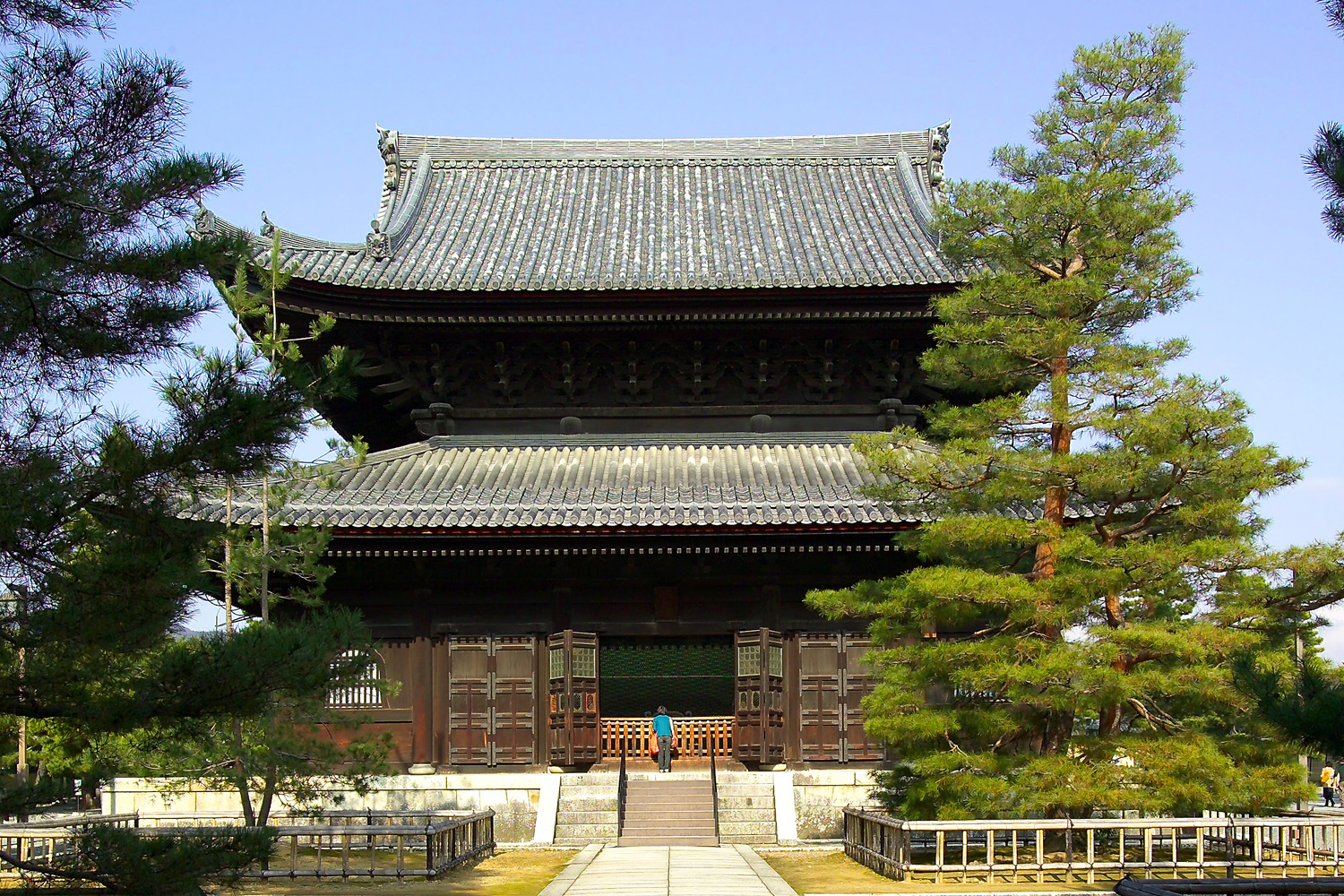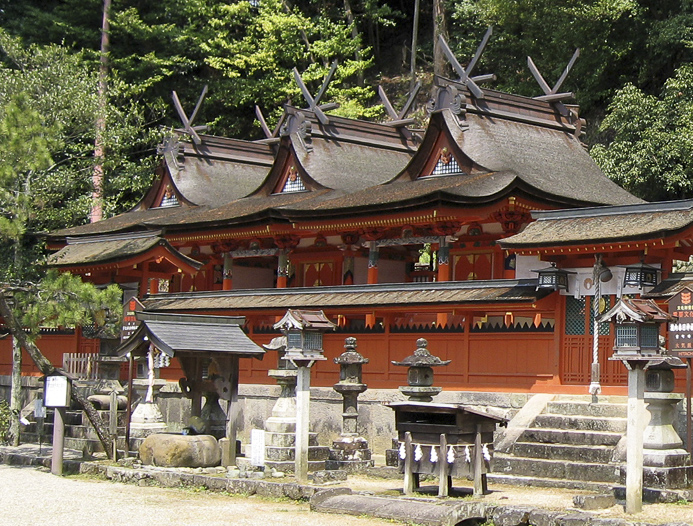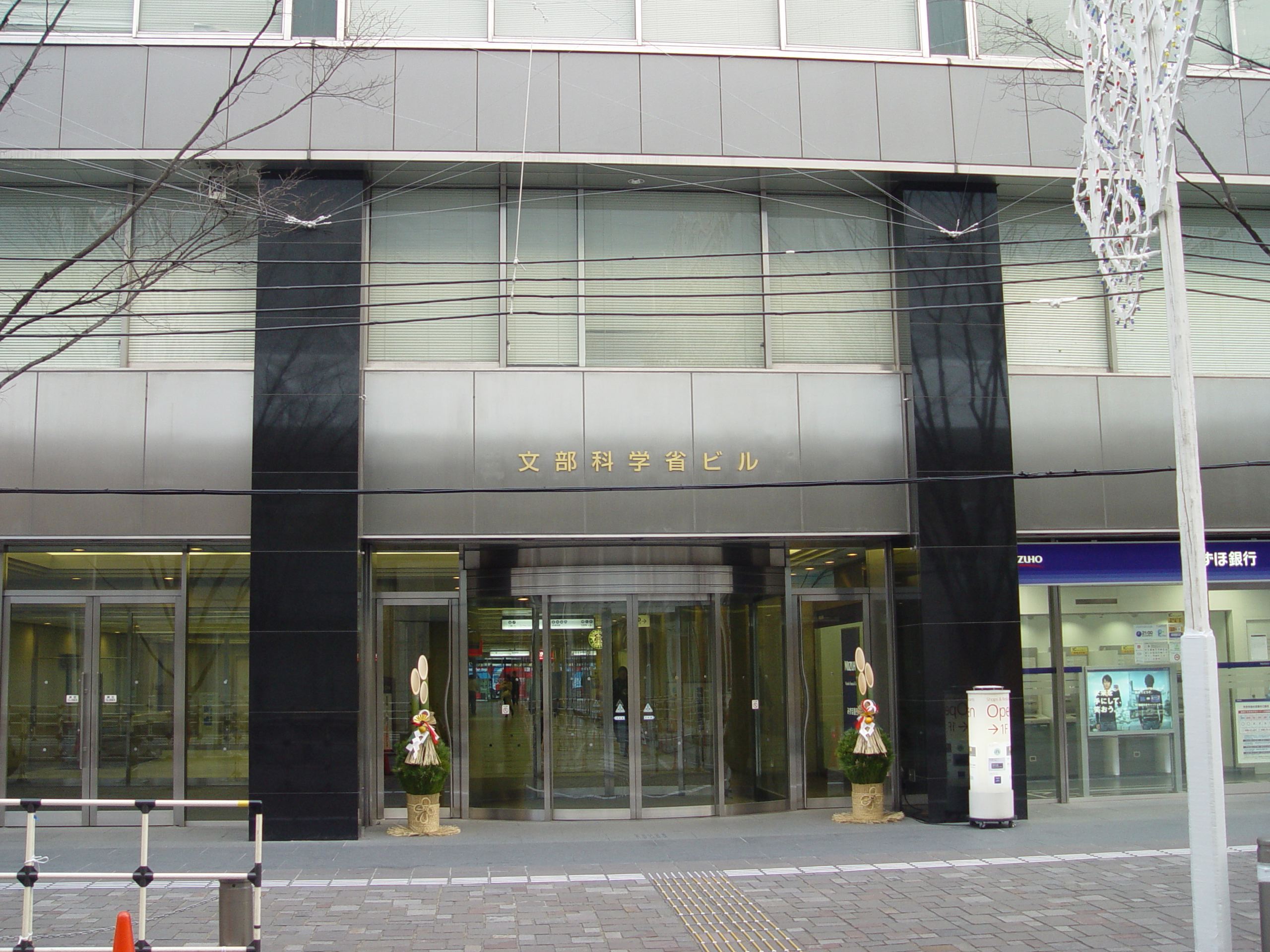|
Enjō-ji
is a Shingon temple in the northeast of Nara, Nara, Nara, Japan. A number of its buildings and images have been designated National Treasures of Japan, National Treasures and Important Cultural Properties of Japan, Important Cultural Properties, and its late-Heian period gardens are a List of Special Places of Scenic Beauty, Special Historic Sites and Special Natural Monuments, Place of Scenic Beauty. History Enjō-ji is said to have been founded in 756 by a Chinese priest who accompanied Ganjin to Japan. The temple was enlarged in the late-Heian period, Heian and Muromachi period, Muromachi periods. Much damage occurred during the Ōnin War, and further losses occurred during the Meiji period and after. Buildings The two-storey Mon (architecture), gate of 1468 and Main Hall (Japanese Buddhism), Hondō of 1472 are both Important Cultural Properties of Japan, Important Cultural Properties. The tahōtō is lost and has been replaced with a modern replica. Also on the grounds ... [...More Info...] [...Related Items...] OR: [Wikipedia] [Google] [Baidu] |
Shingon
is one of the major schools of Buddhism in Japan and one of the few surviving Vajrayana lineages in East Asian Buddhism. It is a form of Japanese Esoteric Buddhism and is sometimes called "Tōmitsu" (東密 lit. "Esoteric [Buddhism] of Tō-ji"). The word ''shingon'' is the Kan-on, Japanese reading of the Traditional Chinese characters, Chinese word ('), which is the translation of the Sanskrit word mantra. The Chinese Esoteric Buddhism, Zhēnyán lineage was founded in China (c. 7th–8th centuries) by Indian Vajracharya, vajrācāryas (esoteric masters) like Śubhakarasiṃha, Vajrabodhi and Amoghavajra. These esoteric teachings would later flourish in Japan under the auspices of a Buddhist monk named Kūkai (, 774–835), who traveled to Tang dynasty, Tang China and received these esoteric transmissions from a Chinese master named Huiguo (746–805). Kūkai established his tradition at Mount Kōya (in Wakayama Prefecture), which remains the central pilgrimage center of Sh ... [...More Info...] [...Related Items...] OR: [Wikipedia] [Google] [Baidu] |
Nara, Nara
is the capital city of Nara Prefecture, Japan. , Nara has an estimated population of 367,353 according to World Population Review, making it the largest city in Nara Prefecture and sixth-largest in the Kansai region of Honshu. Nara is a core city located in the northern part of Nara Prefecture bordering the Kyoto Prefecture. Nara was the capital of Japan during the Nara period from 710 to 784 as the seat of the Emperor before the capital was moved to Nagaoka-kyō, except for the years 740 to 745, when the capital was placed in Kuni-kyō, Naniwa-kyō and Shigaraki Palace. Nara is home to eight major historic temples, shrines, and heritage sites, specifically Tōdai-ji, Saidai-ji, Kōfuku-ji, Kasuga Shrine, Gangō-ji, Yakushi-ji, Tōshōdai-ji, and the Heijō Palace, together with Kasugayama Primeval Forest, collectively form the Historic Monuments of Ancient Nara, a UNESCO World Heritage Site. Etymology By the Heian period, a variety of different characters had ... [...More Info...] [...Related Items...] OR: [Wikipedia] [Google] [Baidu] |
Shinto Shrines
A Stuart D. B. Picken, 1994. p. xxiii is a structure whose main purpose is to house ("enshrine") one or more kami, , the deities of the Shinto religion. The Also called the . is where a shrine's patron is or are enshrined.Iwanami Japanese dictionary The may be absent in cases where a shrine stands on or near a sacred mountain, tree, or other object which can be worshipped directly or in cases where a shrine possesses either an altar-like structure, called a himorogi, , or an object believed to be capable of attracting spirits, called a yorishiro, , which can also serve as direct bonds to a . There may be a and other structures as well. Although only one word ("shrine") is used in English, in Japanese, Shinto shrines may carry any one of many different, non-equivalent names like , , , , , , , , , or . Miniature shrines (hokora, ) can occasionally be found on roadsides. Large shrines sometimes have on their precincts miniature shrines, or . Because the and once had differe ... [...More Info...] [...Related Items...] OR: [Wikipedia] [Google] [Baidu] |
Main Hall (Japanese Buddhism)
Main hall or Main Temple is the building within a Japanese Buddhist monastery compound ('' garan'') which enshrines the main object of veneration.Kōjien Japanese dictionary Because the various denominations deliberately use different terms, this single English term translates several Japanese words, among them ''butsuden'', ''butsu-dō'', ''kondō'', ''konpon-chūdō'', and ''hondō''. ''Hondō'' is its exact Japanese equivalent, while the others are more specialized words used by particular sects or for edifices having a particular structure. Kondō (Asuka and Nara periods) The term started to be used during the Asuka and Nara periods. A ''kondō'' is the centerpiece of an ancient Buddhist temple's ''garan'' in Japan. The origin of the name is uncertain, but it may derive from the perceived preciousness of its content, or from the fact that the interior was lined with gold. This is the name used by the oldest temples in the country.Iwanami Nihonshi Jiten A ''kondō'', for exa ... [...More Info...] [...Related Items...] OR: [Wikipedia] [Google] [Baidu] |
Ganjin
Jianzhen (688–763), also known by his Japanese language, Japanese name Ganjin (,), was a Tang dynasty, Tang Han people, Chinese Buddhist monk, monk who helped to propagate Buddhism in Japan. In the eleven years from 743 to 754, Jianzhen attempted to visit Japan some six times, arriving in the year 753 and founding Tōshōdai-ji in Nara, Nara, Nara. When he finally succeeded on his sixth attempt, he had lost his eyesight as a result of an infection acquired during his journeys. Jianzhen's life story and voyage are described in the scroll, "The Sea Journey to the East of a Great Bonze from the Tang Dynasty." Life Jianzhen was born in Jiangyin county in Guangling Commandery, Guangling Prefecture (present day Yangzhou), China, with the surname of Chunyu (). At the age of fourteen, he became a disciple of Dayun Temple (). At twenty he travelled to Chang'an for study and returned six years later, eventually becoming abbot of Daming Temple. Besides his learning in the Tripiṭaka, J ... [...More Info...] [...Related Items...] OR: [Wikipedia] [Google] [Baidu] |
Kodansha
is a Japanese privately held publishing company headquartered in Bunkyō, Tokyo. Kodansha publishes manga magazines which include ''Nakayoshi'', ''Morning (magazine), Morning'', ''Afternoon (magazine), Afternoon'', ''Evening (magazine), Evening'', ''Weekly Young Magazine'', ''Weekly Shōnen Magazine'', and ''Bessatsu Shōnen Magazine'', as well as the more literary magazines ''Gunzō'', ''Weekly Gendai, Shūkan Gendai'', and the Japanese dictionary, ''Nihongo Daijiten''. Kodansha was founded by Seiji Noma in 1909, and members of his family continue as its owners either directly or through the Noma Cultural Foundation. History Seiji Noma founded Kodansha in 1909 as a spin-off of the ''Dai-Nippon Yūbenkai'' (, "Greater Japan Oratorical Society") and produced the literary magazine, ''Yūben,'' () as its first publication. The name ''Kodansha'' (taken from ''Kōdan Club'' (), a now-defunct magazine published by the company) originated in 1911 when the publisher formally merged wi ... [...More Info...] [...Related Items...] OR: [Wikipedia] [Google] [Baidu] |
Kasuga-taisha
is a Shinto shrine in Nara, Nara Prefecture, Japan. It is the shrine of the Fujiwara family, established in 768 CE and rebuilt several times over the centuries. The interior is famous for its many bronze lanterns, as well as the many stone lanterns that lead up to the shrine. The architectural style '' Kasuga-zukuri'' takes its name from Kasuga Shrine's ''honden'' (sanctuary). The Torii at Kasuga-taisha is one of the oldest in Shinto and helped influence the style of Torii seen across much of Japan. Kasuga Shrine, and the Kasugayama Primeval Forest near it, are registered as a UNESCO World Heritage Site as part of the "Historic Monuments of Ancient Nara". The path to Kasuga Shrine passes through a deer park. In the park, deer are able to roam freely and are believed to be sacred messengers of the Shinto gods that inhabit the shrine and surrounding mountainous terrain. Kasuga Shrine and the deer have been featured in several paintings and works of art of the Nambokucho Peri ... [...More Info...] [...Related Items...] OR: [Wikipedia] [Google] [Baidu] |
Kasuga-zukuri
is a traditional Shinto shrine architectural style which takes its name from Kasuga Taisha's ''honden''. Description It is characterized by the use of a building just 1x1 '' ken'' in size with the entrance on the gabled end covered by a veranda.A ''ken'' is the distance between one supporting pillar and another, a quantity which can vary from shrine to shrine and even within the same building, as in this case. In Kasuga Taisha's case, the ''honden'' is just 1.9 m x 2.6 m.JAANUSKasuga-zukuri accessed on December 1, 2009 Supporting structures are painted vermilion, while the plank walls are white. It has a structure, that is, the building has its main entrance on the gabled side. The roof is gabled (), decorated with purely ornamental poles called '' chigi'' (vertical) or ''katsuogi'' (horizontal), and covered with cypress bark. After the '' nagare-zukuri'' style, this is the most common Shinto shrine style. While the first is common all over Japan, however, shrines with a ''ka ... [...More Info...] [...Related Items...] OR: [Wikipedia] [Google] [Baidu] |
Ken (architecture)
The is a Japanese units of measurement, traditional Japanese unit of length, equal to six Japanese feet (''shaku''). The exact value has varied over time and location but has generally been a little shorter than .JAANUS It is now standardized as 1.82 metre, m. Although mostly supplanted by the metric system, this unit is a common measurement in Japanese architecture, where it is used as a proportion for the intervals between the pillars of traditional-style buildings. In this context, it is commonly translated as "bay". The length also appears in other contexts, such as the standard length of the ''bō'' staff in Japanese martial arts and the standard dimensions of the tatami mats. As these are used to cover the floors of most Japanese houses, floor surfaces are still commonly measured not in square meters but in "tatami" which are equivalent to half of a square ken. Word Among list of English words of Japanese origin, English loanwords of Japanese origin, both ''ken'' and '' ... [...More Info...] [...Related Items...] OR: [Wikipedia] [Google] [Baidu] |
Tahōtō
A is a form of Japanese pagoda found primarily at Vajrayana, Esoteric Shingon and Tendai school Buddhist temples in Japan, Buddhist temples. It is unique among pagodas because it has an even number of stories (two). (The second story has a balustrade and seems habitable, but is nonetheless inaccessible and offers no usable space.) Its name alludes to Prabhutaratna, Tahō Nyorai, who appears seated in a many-jewelled pagoda in the eleventh chapter of the Lotus Sutra. With square lower and cylindrical upper parts, a ''mokoshi'' 'skirt roof', a pyramidal roof, and a finial, the ''tahōtō'' or the larger ''daitō'' was one of the Shichidō garan, seven halls of a Shingon temple. After the Heian period, the construction of pagodas in general declined, and new ''tahōtō'' became rare. Six examples, of which that at Ishiyama-dera (1194) is the earliest, have been designated National Treasures of Japan, National Treasures. There are no examples in Chinese Buddhism, China, whether ... [...More Info...] [...Related Items...] OR: [Wikipedia] [Google] [Baidu] |
Agency For Cultural Affairs
The is a special body of the Japanese Ministry of Education, Culture, Sports, Science and Technology (MEXT). It was set up in 1968 to promote Japanese arts and culture. The agency's budget for FY 2018 rose to ¥107.7 billion. Overview The agency's Cultural Affairs Division disseminates information about the arts within Japan and internationally, and the Cultural Properties Protection Division protects the nation's cultural heritage. The Cultural Affairs Division is concerned with such areas as art and culture promotion, art copyrights, and improvements in the national language. It also supports both national and local arts and cultural festivals, and it funds traveling cultural events in music, theater, dance, art exhibitions, and film-making. Special prizes are offered to encourage young artists and established practitioners, and some grants are given each year to enable them to train abroad. The agency funds national museums of modern art in Kyoto and Tokyo and The National ... [...More Info...] [...Related Items...] OR: [Wikipedia] [Google] [Baidu] |
Mon (architecture)
is a generic Japanese term for gate often used, either alone or as a suffix, in referring to the many gates used by Buddhist temples, Shinto shrines and traditional-style buildings and castles. Significance Unlike gates of secular buildings, most temple and shrine gates are purely symbolic elements of liminality, as they cannot be completely closed and just mark the transition between the mundane and the sacred. In many cases, for example that of the ''sanmon'', a temple gate has purifying, cleansing properties. Description Gate size is measured in '' ken'', where a ''ken'' is the interval between two pillars of a traditional-style building. A temple's '' rōmon'' for example can have dimensions from a maximum of 5x2 ''ken'' to a more common 3x2 ''ken'', down to even one ''ken''. The word is usually translated in English as "bay" and is better understood as an indication of proportions than as a unit of measurement. Like the temples they belong to, gates can be in the ''wa ... [...More Info...] [...Related Items...] OR: [Wikipedia] [Google] [Baidu] |









